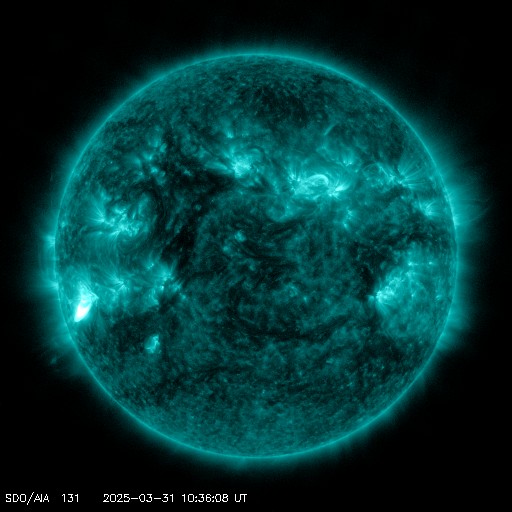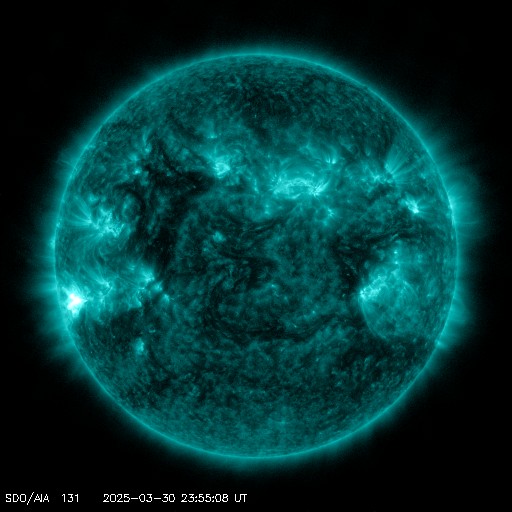Viewing archive of Tuesday, 23 January 2001
Solar activity report
Any mentioned solar flare in this report has a scaling factor applied by the Space Weather Prediction Center (SWPC). Because of the SWPC scaling factor, solar flares are reported as 42% smaller than for the science quality data. The scaling factor has been removed from our archived solar flare data to reflect the true physical units.
Report of Solar-Geophysical Activity 2001 Jan 23 2200 UTCPrepared by the NOAA © SWPC and processed by SpaceWeatherLive.com
Joint USAF/NOAA Report of Solar and Geophysical Activity
SDF Number 023 Issued at 2200Z on 23 Jan 2001IA. Analysis of Solar Active Regions and Activity from 22-2100Z to 23-2100Z
Solar activity was low. Region 9311 (N06W62) produced
today's largest flare, a C4/Sf at 2044Z. This group continues to
show slow growth and has a simple beta magnetic configuration.
Region 9313 (S06E01) continues to show some magnetic complexity but
appears to be decaying slowly. Three new sunspot groups were
assigned today: Region 9322 (S23E00), Region 9323 (S29E03) and
Region 9324 (N10E42). All of these groups were small, simple,
bipolar regions.
IB. Solar Activity Forecast
Solar activity is expected to be
mostly low, but there is a chance for an isolated M-class event
during the next three days. Regions 9313 and 9311 are the most
likely sources for enhanced solar activity.
IIA. Geophysical Activity Summary 22-2100Z to 23-2100Z
The geomagnetic field was at quiet to active levels during the past
24 hours. The field was initially quiet. However, an interplanetary
shock was observed at the ACE spacecraft at 1008Z and was followed
by a sudden impulse at Earth at 1047Z. Solar wind behind the shock
showed sheath-like characteristics, with Bz oscillating from
negative to positive. Bz did appear to be trending toward more
strongly negative values near forecast issue time (about -10 nT).
The geomagnetic field responded by becoming unsettled to active.
The greater than 10 MeV protons remain enhanced (at about 2 pfu)
but did not increase with the shock passage.
IIB. Geophysical Activity Forecast
The geomagnetic field is
expected to be mostly active during the next 12 to 24 hours, with a
chance for isolated storm periods as the current disturbance
continues. A decrease to unsettled to slightly active levels is
expected for the second and third days.
III. Event Probabilities 24 Jan to 26 Jan
| Class M | 35% | 35% | 35% |
| Class X | 05% | 05% | 05% |
| Proton | 05% | 05% | 05% |
| PCAF | green | ||
IV. Penticton 10.7 cm Flux
Observed 23 Jan 167 Predicted 24 Jan-26 Jan 165/165/160 90 Day Mean 23 Jan 174
V. Geomagnetic A Indices
Observed Afr/Ap 22 Jan 008/010 Estimated Afr/Ap 23 Jan 018/015 Predicted Afr/Ap 24 Jan-26 Jan 025/020-012/015-012/015
VI. Geomagnetic Activity Probabilities 24 Jan to 26 Jan
| A. Middle Latitudes | |||
|---|---|---|---|
| Active | 30% | 20% | 20% |
| Minor storm | 25% | 15% | 15% |
| Major-severe storm | 20% | 05% | 05% |
| B. High Latitudes | |||
|---|---|---|---|
| Active | 30% | 35% | 25% |
| Minor storm | 20% | 15% | 15% |
| Major-severe storm | 25% | 10% | 05% |
All times in UTC
Current data suggests there is a slight possibility for aurora to appear at the following high latitude regions in the near future
Whitehorse, YTAnchorage, AK, Fairbanks, AK, Juneau, AK, Utqiagvik, AK
Latest news
Latest forum messages
Unspecified geomagnetic activity 2147AR4048 38AR4046 136Solar Demon 3Aurora photography hints for those of us with smartphones 54
More topicsSupport SpaceWeatherLive.com!
A lot of people come to SpaceWeatherLive to follow the Sun's activity or if there is aurora to be seen, but with more traffic comes higher server costs. Consider a donation if you enjoy SpaceWeatherLive so we can keep the website online!

Latest alerts
11:15 UTC - Solar protons
Minor S1 Solar Radiation Storm - Minor impacts on HF radio through polar regions
10:45 UTC - Solar flare
Moderate M1.26 flare
10:27 UTC - Radio Blackout
Minor R1 radio blackout in progress (≥M1 - current: M1.22)
00:09 UTC - Solar flare
Moderate M1.03 flare
Sunday, 30 March 2025
23:51 UTC - Radio Blackout
Minor R1 radio blackout in progress (≥M1 - current: M1.03)
Space weather facts
| Last X-flare | 2025/03/28 | X1.1 |
| Last M-flare | 2025/03/30 | M1.0 |
| Last geomagnetic storm | 2025/03/27 | Kp5 (G1) |
| Spotless days | |
|---|---|
| Last spotless day | 2022/06/08 |
| Monthly mean Sunspot Number | |
|---|---|
| February 2025 | 154.6 +17.6 |
| March 2025 | 127 -27.6 |
| Last 30 days | 127 -25.7 |




